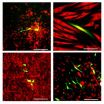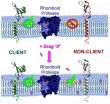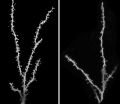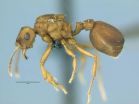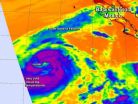(Press-News.org) Johns Hopkins stem cell biologists have found a way to reprogram a patient's skin cells into cells that mimic and display many biological features of a rare genetic disorder called familial dysautonomia. The process requires growing the skin cells in a bath of proteins and chemical additives while turning on a gene to produce neural crest cells, which give rise to several adult cell types. The researchers say their work substantially expedites the creation of neural crest cells from any patient with a neural crest-related disorder, a tool that lets physicians and scientists study each patient's disorder at the cellular level.
Previously, the same research team produced customized neural crest cells by first reprogramming patient skin cells into induced pluripotent stem (iPS) cells, which are similar to embryonic stem cells in their ability to become any of a broad array of cell types.
"Now we can circumvent the iPS cells step, saving seven to nine months of time and labor and producing neural crest cells that are more similar to the familial dysautonomia patients' cells," says Gabsang Lee, Ph.D., an assistant professor of neurology at the Institute for Cell Engineering and the study's senior author. A summary of the study will be published online in the journal Cell Stem Cell on Aug. 21.
Neural crest cells appear early in human and other animal prenatal development, and they give rise to many important structures, including most of the nervous system (apart from the brain and spinal cord), the bones of the skull and jaws, and pigment-producing skin cells. Dysfunctional neural crest cells cause familial dysautonomia, which is incurable and can affect nerves' ability to regulate emotions, blood pressure and bowel movements. Less than 500 patients worldwide suffer from familial dysautonomia, but dysfunctional neural crest cells can cause other disorders, such as facial malformations and an inability to feel pain.
The challenge for scientists has been the fact that by the time a person is born, very few neural crest cells remain, making it hard to study how they cause the various disorders.
To make patient-specific neural crest cells, the team began with laboratory-grown skin cells that had been genetically modified to respond to the presence of the chemical doxycycline by glowing green and turning on the gene Sox10, which guides cells toward maturation as a neural crest cell.
Testing various combinations of molecular signals and watching for telltale green cells, the team found a regimen that turned 2 percent of the cells green. That combination involved turning on Sox10 while growing the cells on a layer of two different proteins and giving them three chemical additives to "rewind" their genetic memory and stimulate a protein network important for development.
Analyzing the green cells at the single cell level, the researchers found that they showed gene activity similar to that of other neural crest cells. Moreover, they discovered that 40 percent were "quad-potent," or able to become the four cell types typically derived from neural crest cells, while 35 percent were "tri-potent" and could become three of the four. The cells also migrated to the appropriate locations in chick embryos when implanted early in development.
The team then applied a modified version of the technique to skin cells from healthy adults and found that the skin cells became neural crests at a rate similar to the team's previous experiments.
Finally, the investigators used their regimen on skin cells from patients with familial dysautonomia, then compared these familial dysautonomia-neural crest cells to the control neural crest cells made from healthy adults. They identified 412 genes with lower activity levels in the familial dysautonomia-neural crest cells, of which 98 are involved in processing RNA products made from active genes.
According to the authors, this new observation offers insight into what goes wrong in familial dysautonomia.
"It seems as though the neural crest cells created directly from patient skin cells show more of the characteristics of familial dysautonomia than the neural crest cells we created previously from induced pluripotent stem cells," says Lee. "That means they should be better predictors of what happens in a particular familial dysautonomia patient, and whether or not a potential treatment will work for any given individual."
The method they devised should also be applicable to skin cells taken from people with any of the other diseases that result from dysfunctional neural crest cells, such as congenital pain disorders and Charcot-Marie-Tooth diseases, Lee says.
INFORMATION:
Other authors of the report include Yong Jun Kim, HoTae Lim, Zhe Li, Yohan Oh, Irina Kovlyagina, InYoung Choi and Xinzhong Dong of the Johns Hopkins University School of Medicine.
This work was supported by grants from the New York Stem Cell Foundation (Robertson Investigator Award) and the Maryland Stem Cell Research Fund (TEDCO).
On the Web:
Link to article (live after embargo lifts): http://dx.doi.org/10.1016/j.stem.2014.07.013
Lee Profile: http://www.hopkinsmedicine.org/profiles/results/directory/profile/800027/gabsang-lee
Biologists reprogram skin cells to mimic rare disease
Additional tool accelerates personalized medicine research
2014-08-21
ELSE PRESS RELEASES FROM THIS DATE:
Sequence of rare kidney cancer reveals unique alterations involving telomerase
2014-08-21
HOUSTON – (Aug. 21, 2014) – An international scientific collaboration led by Baylor College of Medicine has revealed clues about genetic alterations that may contribute to a rare form of kidney cancer, providing new insights not only into this rare cancer but other types as well.
The collaboration, a project of the National Institutes of Health's Cancer Genome Atlas initiative, completed the sequence of chromophobe renal cell carcinoma and published the results today in the journal Cancer Cell.
"The Cancer Genome Atlas is a federally funded national effort that has ...
Some anti-inflammatory drugs affect more than their targets
2014-08-21
Researchers have discovered that three commonly used nonsteroidal anti-inflammatory drugs, or NSAIDs, alter the activity of enzymes within cell membranes. Their finding suggests that, if taken at higher-than-approved doses and/or for long periods of time, these prescription-level NSAIDs and other drugs that affect the membrane may produce wide-ranging and unwanted side effects.
More positively, the researchers say, their work provides the basis for a test that drug developers can use to predict and perhaps avoid these side effects in new medicines they make. A summary ...
Children with autism have extra synapses in brain
2014-08-21
NEW YORK, NY (August 21, 2014) — Children and adolescents with autism have a surplus of synapses in the brain, and this excess is due to a slowdown in a normal brain "pruning" process during development, according to a study by neuroscientists at Columbia University Medical Center (CUMC). Because synapses are the points where neurons connect and communicate with each other, the excessive synapses may have profound effects on how the brain functions. The study was published in the August 21 online issue of the journal Neuron.
A drug that restores normal synaptic pruning ...
Research explains how cellular guardians of the intestine develop
2014-08-21
Even the most careful chosen meal can contain surprises. To defend against infectious microbes, viruses or other potential hazards that find their way to the intestines, a dedicated contingent of immune cells keeps watch within the thin layer of tissue that divides the contents of the gut from the body itself.
New research at Rockefeller University sheds light on the development of a unique class of immune cells known as intraepithelial lymphocytes (IELs) that reside in this critical interface. The findings, published August 21 in Immunity, may help lead to new insights ...
Alternate mechanism of species formation picks up support, thanks to a South American ant
2014-08-21
A newly-discovered species of ant supports a controversial theory of species formation. The ant, only found in a single patch of eucalyptus trees on the São Paulo State University campus in Brazil, branched off from its original species while living in the same colony, something thought rare in current models of evolutionary development.
“Most new species come about in geographic isolation,” said Christian Rabeling, assistant professor of biology at the University of Rochester. “We now have evidence that speciation can take place within a single colony.”
The findings ...
Mouse model for epilepsy, Alzheimer's gives window into the working brain
2014-08-21
(SALT LAKE CITY)—University of Utah scientists have developed a genetically engineered line of mice that is expected to open the door to new research on epilepsy, Alzheimer's and other diseases.
The mice carry a protein marker, which changes in degree of fluorescence in response to different calcium levels. This will allow many cell types, including cells called astrocytes and microglia, to be studied in a new way.
"This is opening up the possibility to decipher how the brain works," said Petr Tvrdik, Ph.D., a research fellow in human genetics and a senior author ...
Hacking Gmail with 92 percent success
2014-08-21
RIVERSIDE, Calif. — A team of researchers, including an assistant professor at the University of California, Riverside Bourns College of Engineering, have identified a weakness believed to exist in Android, Windows and iOS mobile operating systems that could be used to obtain personal information from unsuspecting users. They demonstrated the hack in an Android phone.
The researchers tested the method and found it was successful between 82 percent and 92 percent of the time on six of the seven popular apps they tested. Among the apps they easily hacked were Gmail, CHASE ...
Researchers identify potential risk factors for urinary tract infections in young girls
2014-08-21
Winston-Salem, N.C. – August, 21, 2014 – Young girls with an intense, red, itchy rash on their outer genital organs may be at increased risk of developing urinary tract infections (UTIs), according to new research from Wake Forest Baptist Medical Center. The treatment may be as simple as better hygiene and avoiding potential irritants such as bubble baths and swimming pools.
"Vulvitis is a common condition affecting women and girls of all ages," said senior author Steve J. Hodges, M.D., associate professor of urology at Wake Forest Baptist. "We found that girls with ...
Difficulty assessing effort drives motivation deficits in schizophrenia, study finds
2014-08-21
SAN FRANCISCO, Aug. 21, 2014 – Individuals with schizophrenia often have trouble engaging in daily tasks or setting goals for themselves, and a new study from San Francisco State University suggests the reason might be their difficulty in assessing the amount of effort required to complete tasks.
The research, detailed in an article published this week in the Journal of Abnormal Psychology, can assist health professionals in countering motivation deficits among patients with schizophrenia and help those patients function normally by breaking up larger, complex tasks into ...
A NASA satellite double-take at Hurricane Lowell
2014-08-21
Lowell is now a large hurricane in the Eastern Pacific and NASA's Aqua and Terra satellites double-teamed it to provide infrared and radar data to scientists. Lowell strengthened into a hurricane during the morning hours of August 21.
When NASA's Aqua satellite passed over Lowell on August 20 at 21:05 UTC (4:05 p.m. EDT), the Atmospheric Infrared Sounder got an infrared look at Lowell's cloud top temperatures when it was still a tropical storm. AIRS showed a very thick band of thunderstorms surrounding the center of circulation and what appeared to be a very small cloud-free ...
LAST 30 PRESS RELEASES:
Eye for trouble: Automated counting for chromosome issues under the microscope
The vast majority of US rivers lack any protections from human activities, new research finds
Ultrasound-responsive in situ antigen "nanocatchers" open a new paradigm for personalized tumor immunotherapy
Environmental “superbugs” in our rivers and soils: new one health review warns of growing antimicrobial resistance crisis
Triple threat in greenhouse farming: how heavy metals, microplastics, and antibiotic resistance genes unite to challenge sustainable food production
Earthworms turn manure into a powerful tool against antibiotic resistance
AI turns water into an early warning network for hidden biological pollutants
Hidden hotspots on “green” plastics: biodegradable and conventional plastics shape very different antibiotic resistance risks in river microbiomes
Engineered biochar enzyme system clears toxic phenolic acids and restores pepper seed germination in continuous cropping soils
Retail therapy fail? Online shopping linked to stress, says study
How well-meaning allies can increase stress for marginalized people
Commercially viable biomanufacturing: designer yeast turns sugar into lucrative chemical 3-HP
Control valve discovered in gut’s plumbing system
George Mason University leads phase 2 clinical trial for pill to help maintain weight loss after GLP-1s
Hop to it: research from Shedd Aquarium tracks conch movement to set new conservation guidance
Weight loss drugs and bariatric surgery improve the body’s fat ‘balance:’ study
The Age of Fishes began with mass death
TB harnesses part of immune defense system to cause infection
Important new source of oxidation in the atmosphere found
A tug-of-war explains a decades-old question about how bacteria swim
Strengthened immune defense against cancer
Engineering the development of the pancreas
The Journal of Nuclear Medicine ahead-of-print tip sheet: Jan. 9, 2026
Mount Sinai researchers help create largest immune cell atlas of bone marrow in multiple myeloma patients
Why it is so hard to get started on an unpleasant task: Scientists identify a “motivation brake”
Body composition changes after bariatric surgery or treatment with GLP-1 receptor agonists
Targeted regulation of abortion providers laws and pregnancies conceived through fertility treatment
Press registration is now open for the 2026 ACMG Annual Clinical Genetics Meeting
Understanding sex-based differences and the role of bone morphogenetic protein signaling in Alzheimer’s disease
Breakthrough in thin-film electrolytes pushes solid oxide fuel cells forward
[Press-News.org] Biologists reprogram skin cells to mimic rare diseaseAdditional tool accelerates personalized medicine research
